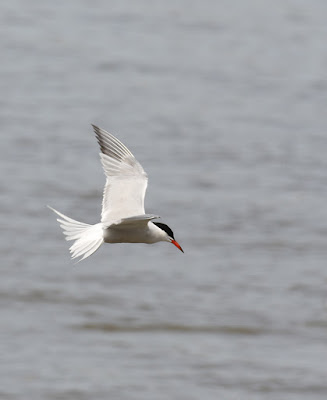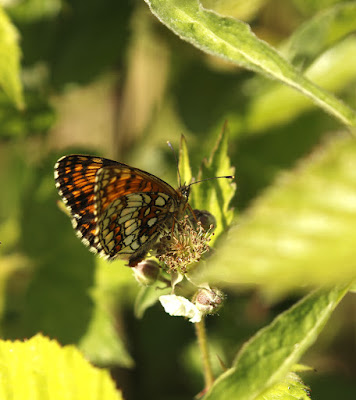I arranged to meet Peter in the main car park at Bernwood Forest at 1030am today for our annual audience with H.I.M (His Imperial Majesty) otherwise known as the Purple Emperor, arguably Britain's most impressive and enigmatic native butterfly. We had to wait for twenty minutes for the sun to come through the clouds but then we made our way onto the main track that runs through the forest and awaited developments.
 |
| The track from the car park at Bernwood.The first half mile is usually the best to encounter an Emperor |
Ten minutes later another Emperor landed further down the track and we hastened towards where it was sucking up minerals from the side of the track, its wings only partially open. It did not remain long before flying again, cruising around at high speed, fairly low over a grassy ride, then frustratingly disappearing up into the surrounding oak trees.
Another Emperor was sighted flying up the track in the direction of the car park and eventually settled but again did not remain on the ground for long, no more than a minute, but giving enough time for me to record an image of its hidden glory, the lustrous, purple blue iridescence on one of its wings.
Another Emperor was sighted flying up the track in the direction of the car park and eventually settled but again did not remain on the ground for long, no more than a minute, but giving enough time for me to record an image of its hidden glory, the lustrous, purple blue iridescence on one of its wings.
This morning was looking very propitious and soon another Emperor came down from the trees to examine the ground and looked to be settled for a prolonged stay. However it was getting crowded round this butterfly as there were not only four butterfly enthusiasts clustered around it but also a party of ten ramblers who had joined us, wondering what was going on.
I looked up and two more Emperors were high above us, flying in close formation around the top of one of the large oaks, their size and prolific white markings immediately identifying them, and then yet another cruised low, further down the track and, following it in my bins, I saw that it had landed some way in the distance by the edge of the track.
It was noisy and unsettling with all the chatter from the ramblers encircled around the Emperor we were currently admiring, although you can hardly blame their excitement at seeing and being told about such a spectacular butterfly. The main track through the wood is used by a lot of people, many of whom are totally unaware of the presence of Emperors but if informed of what we are all getting so excited about are just as thrilled as we are to see one.
Quietly I slipped away from the crowd and walked the hundred metres to where I had noted the Emperor had landed and as I made my way there I put up another that, unseen, had come down to feed on the track. To see this number of Emperors here was unprecedented but I was hardly complaining as sometimes you can really struggle to see even one. This is the enigma of the Purple Emperor, as it can bring intense joy or disappointment in equal measure.
I calculated that in a fairly short space of time we had already encountered at least seven Emperors.
I located the Emperor that I had seen flying down the track and fortunately, Peter noting my departure joined me, and we had it to ourselves to enjoy without any possible disturbance. It was in absolutely pristine condition, possibly hatched this morning and I could but admire the velvety brown of its wings and the two orange rings and lines at the extremity of its hind wings. As the Emperor fed, and due to its position on the verge, we were obliged to view it from its rear and the butterfly as per usual at this angle betrayed none of the famed purple iridescence. Its hidden secret. Its delightful surprise.
For ten minutes we admired it and it looked set to remain for quite some time but sadly our audience was not to last as some dreaded dog walkers, the bane of any Emperor watcher at Bernwood, arrived and their dog promptly ran up to us and caused the butterfly to flee up into a sallow bush where it crash landed in the leaves, and although perched in a very undignified fashion seemed perfectly happy there before dropping down to the vegetation below. However this lowly location was not to its aristocratic taste and it flew off in less than a minute.
For ten minutes we admired it and it looked set to remain for quite some time but sadly our audience was not to last as some dreaded dog walkers, the bane of any Emperor watcher at Bernwood, arrived and their dog promptly ran up to us and caused the butterfly to flee up into a sallow bush where it crash landed in the leaves, and although perched in a very undignified fashion seemed perfectly happy there before dropping down to the vegetation below. However this lowly location was not to its aristocratic taste and it flew off in less than a minute.
We hung around for some time but there were no more sightings on this area of track so we decided to walk the whole length of the track, which is a mile and a half. The walk produced three more Emperors which, like the ones earlier, cruised low along the track but settled only briefly before flying off up into the oaks on either side of the track. Notably, one of these was a female. Larger than the male and without any purple iridescence on her wings. Just plain dark brown and white. I say just! She was magnificent! Retracing our steps we came across yet another Emperor which like all the others was restless and unwilling to settle.
Over the years I have found the secret with Emperors is to allow them the time, when they come down from the trees, to find a patch of minerals to their liking before approaching them. This can take some minutes as the butterfly settles and then wanders around on the ground seeking the exact minerals it desires. Sometimes it fails in its quest and then, with a distinctive, fluttering, halting flight will cruise low over the ground, back and fore, seeking another likely spot. This is when the Emperor watcher's anxiety levels reach maximum. Will it settle or will it power off back up into the trees? Seconds can seem like an age. Despite deploying this tactic of wait and see, today the Emperors, with two notable exceptions this morning, had all proved restless and unwilling to settle.
Once an Emperor does find a spot to its liking and settles, virtually nothing will move it until it is satisfied it has sucked up enough minerals and salts. Such a moment came to pass as we came to where the track sloped downhill, descending to the little culvert by the meadow and saw four people crouched low over something on the track. It had to be an Emperor and it certainly was, a superb pristine male.
Two enthusiastic ladies were taking pictures of it with their phones and I joined in, getting some nice shots of its underwing pattern but I wanted, as does everyone in any encounter with an Emperor some images of its wings showing the regal purple. This colouring can only be seen from certain angles and to achieve such an image requires careful positioning to get just the right angle in relation to the butterfly. I was getting close to achieving this when one of the ladies got that bit too close in her enthusiasm to get the ultimate image on her phone and the Emperor took offence and flew off. Just another few seconds and I would have got the image I so desired Here was another manifestation of an Emperor watcher's frustration, in that there always seems to be someone who cannot control their impetuosity.
 |
| White Admiral |
The iridescence only shows from certain angles where refracted light creates the purple colour. When this happens it is like a bolt of lightening as the light causes the purple to flash for a moment but then the slightest movement from the insect, causing a change of angle, makes the colour disappear just as suddenly as it appeared, as with a light being switched off.
 |
| All the above four images are of the same Emperor |
The Emperor fed on, now impervious to us standing virtually over it. Gently I removed blades and stalks of wayward grass close by it so we could get an uninterrupted image. Slowly I moved around the feeding insect, positioning myself for when it might spread its wings. Tantalisingly it would partially open its wings to reveal a flash of purple but almost immediately closed its wings once more. It went on in this way for some time, the Emperor granting teasing, flickering flashes of purple that were hard to catch with the camera before the wings were closed up again. Slowly, at last, it spread its wings wide. I was in position and here, after what seemed forever, was the image before me that I craved and Peter and myself found ourselves looking at the glory of its purple coloured wings, their magnificence visible for all to see. I took many images, far too many, over excitement and exuberance getting the better of me but why shouldn't my enthusiasm carry me away? Here was the moment, by no means guaranteed, that I had been anticipating for an entire year, in fact years as these are easily the best images I have ever managed of a Purple Emperor. Peter too was swept up in the moment but to a lesser extent, both of us excited and happy at this triumphant end to a superb day of Emperor chasing.
We stayed with H.I.M. until he was replete and then he furled his lemon yellow proboscis and wandered a few steps on the track before taking to the air and flew back up into the trees.
We stayed with H.I.M. until he was replete and then he furled his lemon yellow proboscis and wandered a few steps on the track before taking to the air and flew back up into the trees.
We walked slowly back to the car park and yet another Emperor was cruising the short path from the track to the car park. We estimated we had seen thirteen Emperors in a morning, the most I have ever achieved at Bernwood.
I have read on Matthew Oate's Purple Empire web site see here that he thinks this prolonged hot weather is causing the Emperors to come low to seek out the moister, shaded hedgerows as the tree tops are becoming too hot for them.
Whether he is right or not, I can only rejoice in my good fortune. I am going back for more. No question about that!
Postscript
I went back to Bernwood two days later, on Saturday morning, and saw eight Purple Emperors in a space of two hours but true to the enigma that is a Purple Emperor only one settled on the ground in that time, and then was in shaded long grass where it kept its wings firmly closed and so was un-photographable. All the others were found perched in trees, one imbibing sap from a bough, behaviour which I had heard of but not seen before.
 |
| The Emperor on his Throne! |




















































































